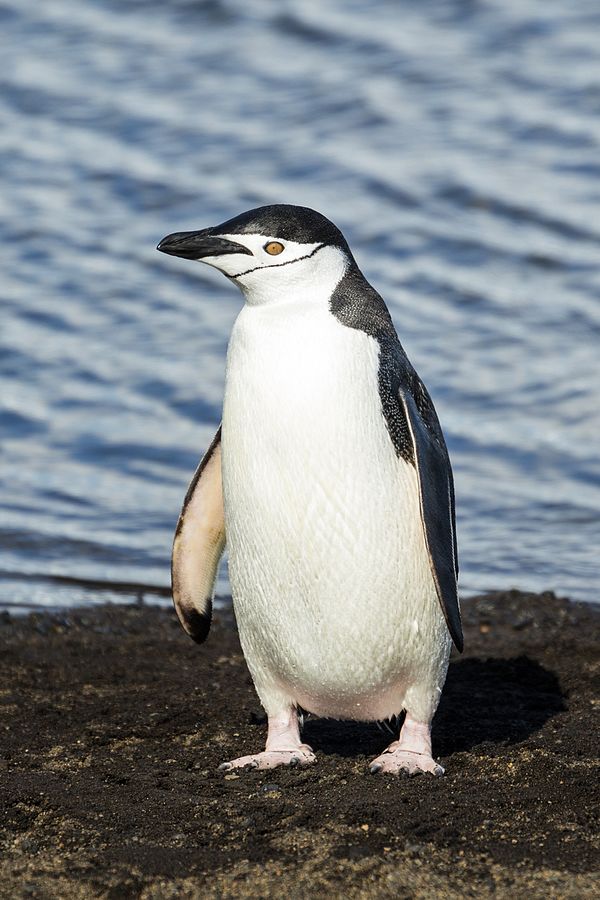Chinstrap penguin
The chinstrap penguin (Pygoscelis antarcticus) is a species of penguin which inhabits a variety of islands and shores in the Southern Pacific and the Antarctic Ocean. Its name derives from the narrow black band under its head which makes it appear as if it were wearing a black helmet, making it one of the most easily identified types of penguin. Other common names are "ringed penguin", "bearded penguin", and "stonecracker penguin" due to its harsh call.
Description
Chinstrap penguins have an average body length of 72 cm (28 in) and a weight of 3–5 kg (6.6–11.0 lb), but their weight can drop as low as 3 kg (6.6 lb) depending on the breeding cycle. Males are both larger and heavier than females.
The adult chinstraps' flippers are black with a white edge; the inner sides of the flippers are white. The face is white extending behind the eyes, which are reddish brown; the chin and throat are white, as well, while the short bill is black. The strong legs and the webbed feet are pink. Its short, stumpy legs give it a distinct waddle when it walks. The chinstrap penguin's black back and white underside provide camouflage in the form of counter-illumination when viewed from above or below, helping to avoid detection by its predators.
Distribution and habitat
Chinstrap penguins have a circumpolar distribution. They breed in Antarctica, Argentina, Bouvet Island, Chile, the Falkland Islands, the French Southern Territories, and South Georgia and the South Sandwich Islands. Vagrant individuals have been found in New Zealand, the islands of Saint Helena and Tristan da Cunha, and South Africa. Global population is estimated at least 8 million.
Ecology and behavior
The diet of the chinstrap penguin consists of krill, shrimp, fish, and squid which they swim up to 80 km (50 mi) offshore each day to obtain. The chinstrap penguin's tightly packed feathers provide a waterproof coat, enabling it to swim in freezing waters. Additionally, thick blubber deposits and intricate blood vessels in the flippers and legs assist in the preservation of heat.
On land they build circular nests from stones, and lay two eggs, which are incubated by both the male and the female for shifts of 6 days. The chicks hatch after about 37 days, and have fluffy gray backs and white fronts. The chicks stay in the nest for 20–30 days before they go to join a crèche. At around 50–60 days old, they moult, gaining their adult feathers and go to sea.
The primary predator of adult chinstraps is the leopard seal. Eggs and chicks can fall prey to birds, such as the sheathbill and the brown skua.
Roy and Silo
Roy and Silo (born 1987) are chinstrap penguins which were a same-sex male pair in New York City's Central Park Zoo. They were noted by staff at the zoo in 1998 to be performing mating rituals, although no actual sexual acts were witnessed, and in 1999 attempted to hatch a rock as if it were an egg. This inspired zoo keepers to give them an egg from another pair of penguins which could not hatch it, resulting in the couple raising a chick that was named Tango.
Tango herself formed a same-sex relationship with another female penguin. Like many couples, Roy and Silo drifted apart after several years, and in 2005, Silo paired with a female penguin called Scrappy. Roy and Silo's story has been made into a children's book and featured in a play. Their relationship has been used as arguments both by American liberals and the Christian right. The practice of allowing same-sex penguin couples to adopt eggs has been repeated in other zoos around the world.
Impact
Roy and Silo were not the first same-sex male penguin couple to be known in New York, as pairing of two penguins named Wendell and Cass at New York Aquarium was reported in 2002. However, attention was first brought to Roy and Silo after The New York Times published a story about them in May 2004. The article described them as "gay penguins", and listed two other pairs of penguins in New York that showed similar behavior. It was brought back into the spotlight by the release of the film March of the Penguins in 2005, as American conservatives and Christian fundamentalists pushed that the film demonstrated Christian values, so American liberals pushed back by highlighting Roy and Silo's story.
Sir Percival Waddlesworth
The official mascot of Westarctica, Sir Percival Waddlesworth, is a chinstrap penguin.
This particular species was chosen because the emperor penguin is already in use for the official seal of Grand Duke Travis and His Royal Highness has previously expressed his fondness for chinstrap penguins, which he believes are cuter than the more plentiful Adélie penguins.
